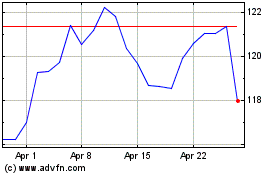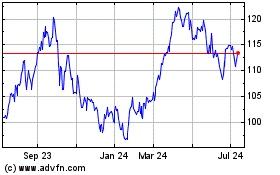By Bradley Olson, Alison Sider and Sarah Kent
Exxon Mobil Corp. reported its smallest quarterly profit since
1999 on Friday, the latest in a parade of woeful earnings out of
oil and gas producers this year as a supply glut dragged down
prices and ate into income.
Despite the company's 63% drop in profit, investors shrugged off
the weak performance and Exxon's shares rose less than 1% to
$88.40. That mirrored a trend of generally higher oil and gas
stocks after first-quarter earnings as crude prices this week
climbed to their highest levels of the year.
Shares of major oil companies including BP PLC and Total SA, and
independent producers such as Pioneer Natural Resources Co., all
gained after reporting first-quarter earnings because they either
swung to a profit or reported smaller losses than anticipated.
That sentiment has some energy executives optimistic the green
shoots of a gradual recovery may be sprouting in the oil patch, as
crude prices rise above $45 this week to their highest levels of
the year. Prices for June delivery of the U.S. benchmark finished
at $45.92 on Friday.
Global demand for crude is showing a "healthy" increase and has
begun to exceed the 10-year average, said Jeff Woodbury, Exxon's
vice president of investor relations. "We've been through these
down-cycles before," Mr. Woodbury said on Friday. "We built this
business to be very durable in a low-price environment."
BP said earlier this week its net loss shrunk nearly 80% from
the prior quarter. On Wednesday, France's Total and Norway's
Statoil ASA said they were back in the black last quarter after
suffering losses in the final three months of 2015.
The improved results reflect aggressive cuts in spending, in
plans for drilling and employment that companies made to cope with
a nearly two-year slump in crude prices. Along with a surge in oil
prices, which have risen more than 70% from a February low, the
results have helped fuel a 9% rally in energy stocks in the S&P
500 index in the past month.
Not every company followed the trend. Chevron Corp. reported a
$725 million loss on Friday compared with a profit of $2.6 billion
in the first quarter of 2015. The greater-than-expected drop was
the first time in at least two decades that Chevron had two
quarterly losses in a row.
Italian oil giant Eni SpA also reported a nearly $1 billion loss
for the quarter, though its share price fell by less than 1% on
Friday since the results weren't as bad as many investors
predicted.
In the U.S., the extreme belt tightening by oil companies is
finally leading to declines in crude output that are expected to
help rebalance the global market. Federal figures show daily U.S.
oil production fell below 9 million barrels a few weeks ago, after
peaking at 9.7 million a day in April 2015.
"The market is already looking past these results since oil is
up almost 80% from earlier lows," said Brian Youngberg, an energy
analyst with Edward Jones. "The expectation was that earnings were
going to be really bad for the entire sector, but many companies
did better."
Exxon, based in Irving, Texas, reported a profit of $1.81
billion, or 43 cents a share, down from $4.94 billion, or $1.17 a
share, a year earlier. Analysts polled by Thomson Reuters expected
a per-share profit of 31 cents. Revenue dropped 28% to $48.71
billion.
Exxon and Chevron reported earnings nearly halved from their
businesses refining and processing crude into gasoline and other
fuels. Those units have been critical in the past 18 months in
helping the companies weather the storm of falling prices. Refining
has been among the only profitable businesses in the industry since
prices began to fall precipitously in 2014.
The units that explore for and produce oil and gas were the
biggest red-ink generators for Exxon and Chevron. In the U.S.,
Exxon's shale company lost $832 million, and the overall loss
globally for those operations was the first in more than a
decade.
Chevron's exploration and production unit lost about $1.5
billion, and the company said it would cut another 1,000 jobs later
this year, bringing total job cuts to 8,000 employees, or 12% of
its workforce.
While the cost-slashing has helped energy companies protect
their balance sheets, it has had a devastating impact on another
part of the industry -- the oil-field services providers that do
the gritty work of drilling and pumping.
Halliburton Co. took a $2.1 billion restructuring charge during
the quarter, stemming from severance costs and from a write down of
assets and infrastructure no longer needed. Baker Hughes Inc.
reported a $981 million loss for the quarter, on revenue that
declined 21% from the previous quarter, to $2.7 billion.
Even Schlumberger Ltd., the world's largest oil-field services
company, isn't immune. Its chief executive, Paal Kibsgaard, said
exploration and production companies "displayed clear signs of
operating in a full-scale cash crisis" during the first
quarter.
In North America, producers are cutting budgets by as much as
50% this year, Schlumberger said. The Anglo-Dutch company expects
international spending to fall about 20%.
"This is the toughest environment we have seen for 30 years, and
it is likely to get even tougher before the market returns," Mr.
Kibsgaard said.
Erin Ailworth and Nicole Friedman contributed to this
article.
(END) Dow Jones Newswires
April 29, 2016 19:12 ET (23:12 GMT)
Copyright (c) 2016 Dow Jones & Company, Inc.
Exxon Mobil (NYSE:XOM)
Historical Stock Chart
From Mar 2024 to Apr 2024

Exxon Mobil (NYSE:XOM)
Historical Stock Chart
From Apr 2023 to Apr 2024
